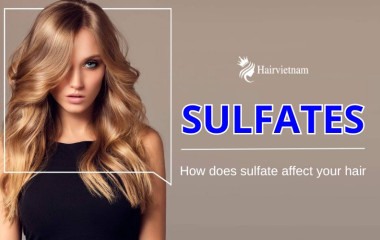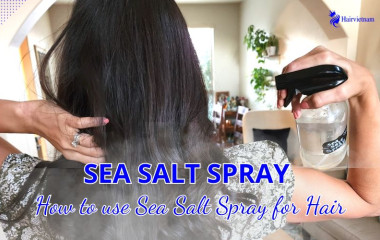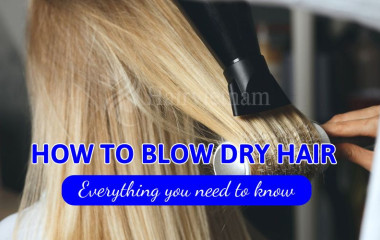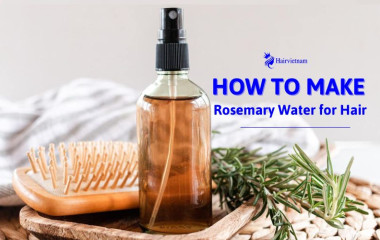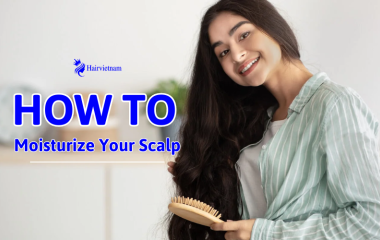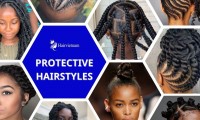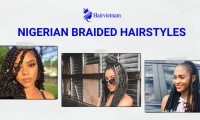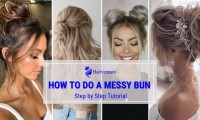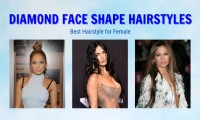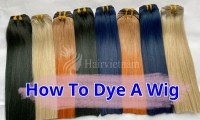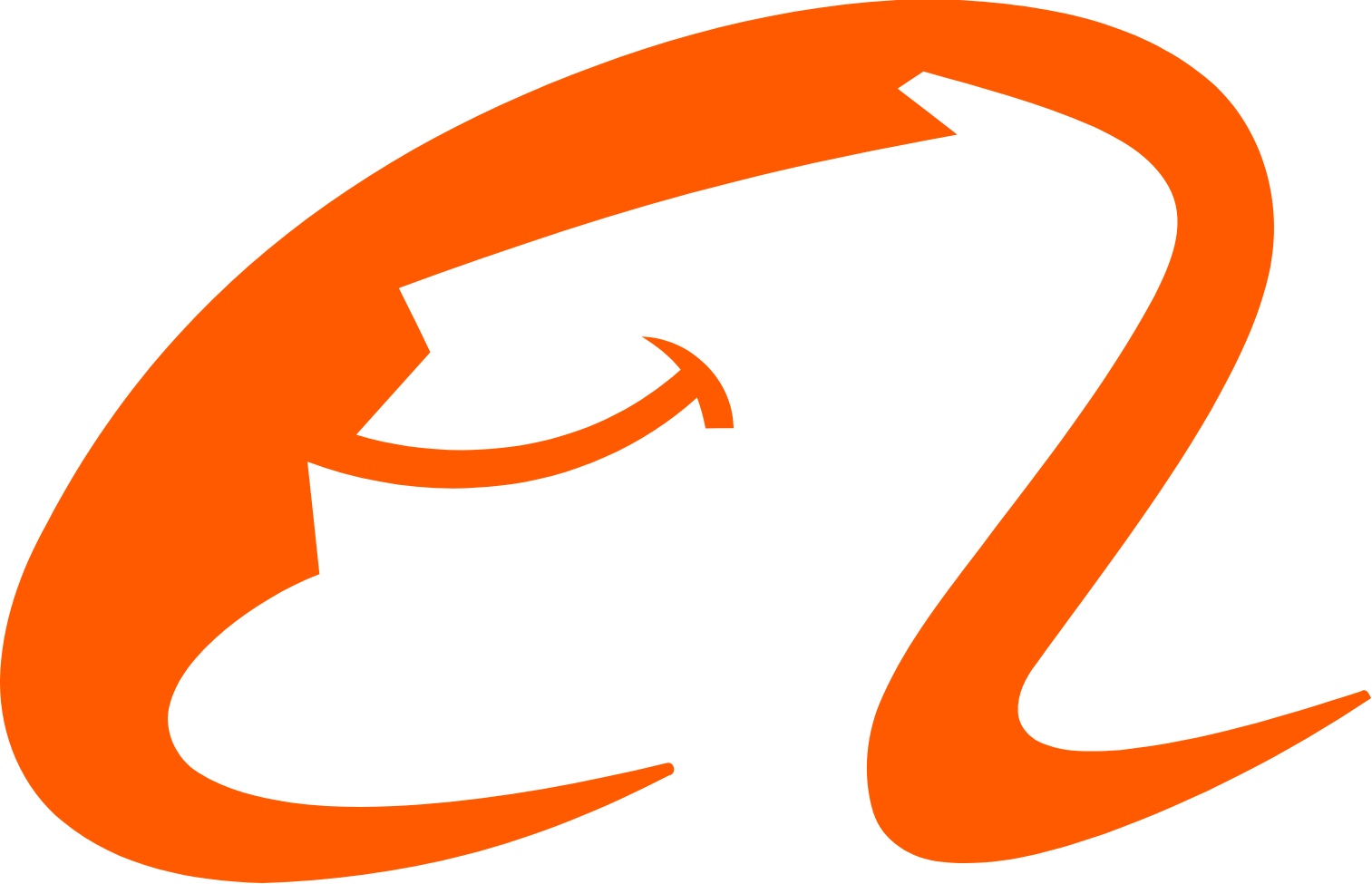What Are the Benefits of Hair Brushing? How to Do It Properly
22/12/2023
Content
To maintain healthy hair, it's crucial to comprehend proper care and brushing techniques. So, What are the benefits of hair brushing? , and How to do it properly? Follow along in this article to unravel the answers and gain valuable insights into fostering the well-being of your hair.
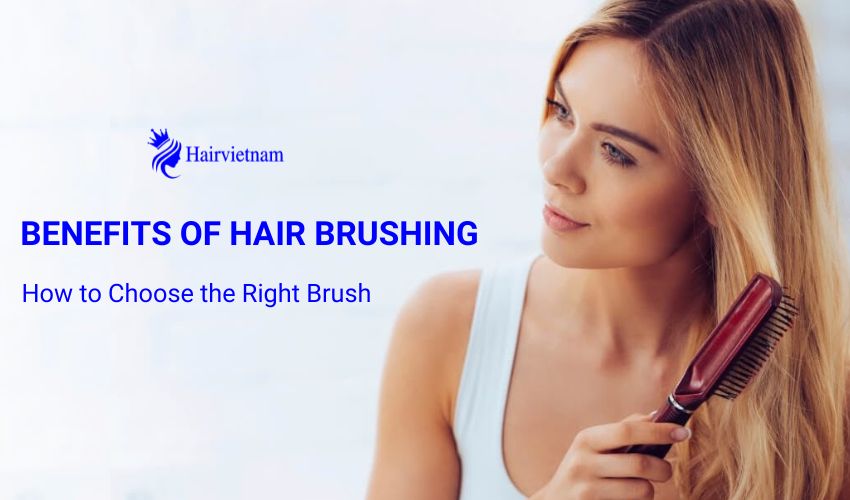
The Benefits of Hair Brushing
However, individual hair conditions play a pivotal role. For those with oily hair, more frequent brushing can assist in managing excess oil. Conversely, if your hair tends to be dry and prone to breakage, a less frequent brushing routine with a gentle, soft-bristle brush might be a more fitting choice. Understanding your hair's unique needs will help you determine the ideal brushing frequency for maintaining both the health and natural beauty of your hair.
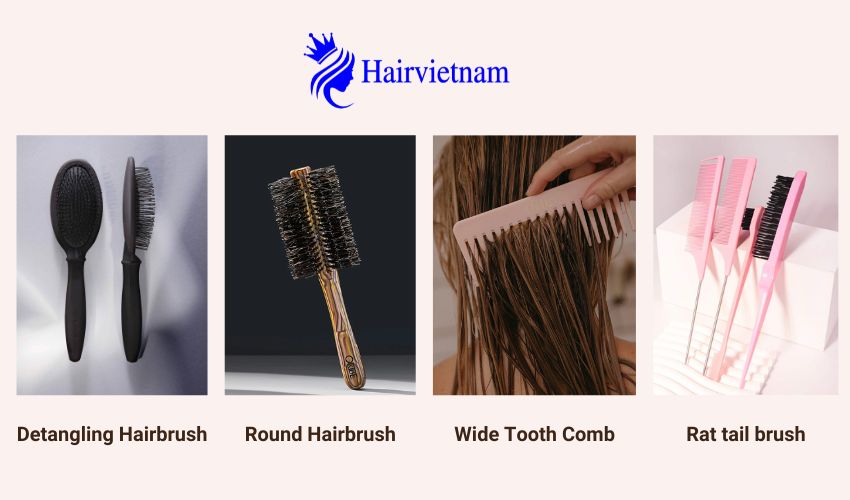
How to Choose the Right Brush
You can use the Wide Tooth Comb with a gentle touch, tying your hair into a loose bun before bedtime to prevent tangles and waking up to effortlessly manageable hair every morning.
Thick Hair: Opt for a paddle brush, especially one with a mix of boar hair and nylon pins. The sturdy nylon pins swiftly handle thick hair, while boar hair boosts shine by distributing natural oils evenly.
Long Hair: Paddle brushes work well for long hair, enabling you to brush through large sections at once, eliminating knots, and evenly redistributing oils.
Straight Hair: Paddle brushes excel with straight, long hair—effortlessly managing large sections and evenly distributing oils. Choose a rubber-padded brush for static-prone straight hair.
Thinning hair: Choose a soft bristle brush for thinning hair, ensuring a gentle touch without causing breakage. For added volume at the crown, opt for a smaller teasing brush designed to reach the hair's roots.
Curly hair: Reach for a robust, wide-toothed comb in the shower to dodge frizz and breakage. Detangling brushes with firm bristles also do the trick.
Breakage Prevention: For knot-induced breakage, choose a detangling brush with flexible bristles that bend with the hair, preventing damage and breakage.
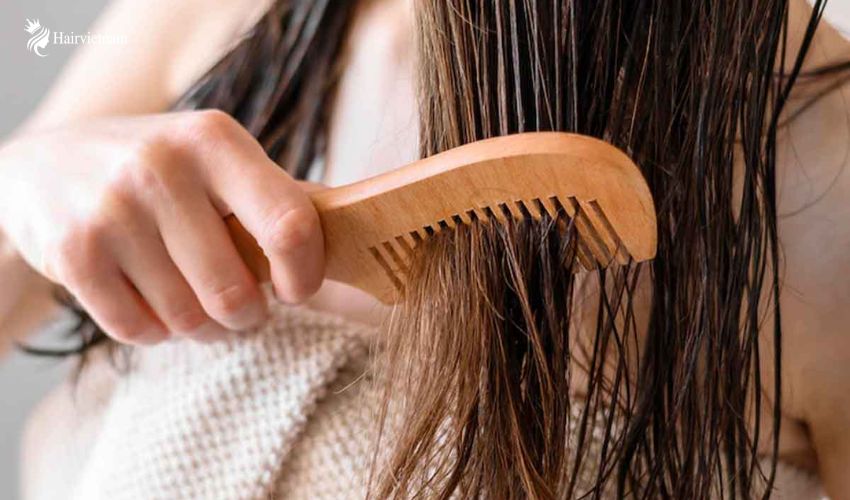
How to brush wet hair
If your hair tends to become more tangled, consider using detangling products or a leave-in conditioner to ensure a smoother glide for the strands during brushing.
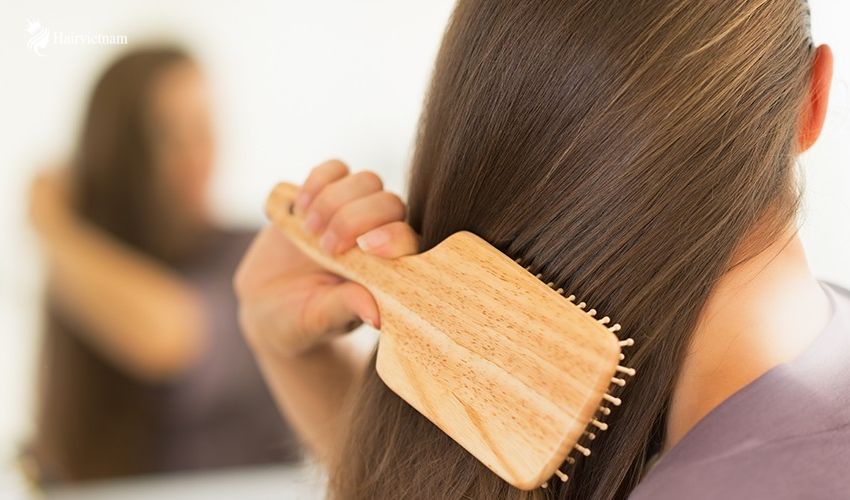
How to brush dry hair
Using the wrong type of brush: Choosing a brush that is not suitable for your hair type can lead to damage and breakage.
Brushing from the scalp to the ends: This method creates tension on knots, causing damage in the middle of the hair and making it prone to breakage.
Skipping pre-shampoo brushing: Wet hair is more vulnerable to damage, so it's important to brush and detangle before shampooing to minimize potential harm.
Excessive brushing throughout the day: Brushing your hair too often can lift the cuticle layer and lead to breakage.
By avoiding these mistakes, you can maintain healthier, more resilient hair.
The correct technique of hair brushing contributes to softer, less tangled, and reduced hair breakage. We hope that HairVietNam's insights have provided you with a better understanding of the benefits of hair brushing, the selection of suitable brushes, and the importance of brushing your hair correctly.
1. The Benefits of Hair Brushing
Brushing your hair brings numerous fantastic benefits to the health of your tresses. Let's explore the outstanding advantages of hair brushing as shared by HairVietNam below.
The Benefits of Hair Brushing
1.1 Stimulating the Scalp
Gently brushing your hair serves as a delightful scalp massage, invigorating blood circulation, and enhancing the supply of oxygen and nutrients. This ritual not only strengthens your hair from the roots but also brings about a comforting sensation, effectively easing muscle tension and promoting a sense of relaxation.1.2 Balancing Natural Oils
The scalp's sebaceous glands work to produce natural oils, imparting essential moisture to the hair. A notable perk of regular hair brushing lies in its ability to evenly distribute these natural oils from the hair's roots, journeying through the cuticle layer and reaching the tips. This gentle distribution not only imparts a lustrous shine but also minimizes the risk of dryness, stiffness, or breakage, leaving your hair nourished and resilient.1.3 Cleansing the Scalp
Gentle hair brushing effectively clears away the itch-inducing, flaky remnants, ensuring a refreshed scalp. Moreover, this practice helps eliminate lingering product residue that can lead to dandruff, allowing anti-dandruff shampoos to penetrate the scalp more deeply for enhanced efficacy.1.4 Effortless Hair Maintenance
Experts suggest that shedding 50-100 strands of hair daily is completely natural. Regular brushing gently aids in detangling and removing these loose strands, preventing them from causing blockages in the hair follicles.Learn More: What Causes Split Ends Hair and How to Prevent Split Ends
2. How many times a day should you brush your hair?
As per experts' advice, it's generally recommended not to exceed brushing your hair twice a day—once in the morning and once at night. This practice prevents overstimulating the oil glands, reducing the risk of breakage and damage while imparting a glossy, effortlessly untangled appearance to your hair.However, individual hair conditions play a pivotal role. For those with oily hair, more frequent brushing can assist in managing excess oil. Conversely, if your hair tends to be dry and prone to breakage, a less frequent brushing routine with a gentle, soft-bristle brush might be a more fitting choice. Understanding your hair's unique needs will help you determine the ideal brushing frequency for maintaining both the health and natural beauty of your hair.
3. How to Choose the Right Brush
When it comes to choosing the perfect hairbrush, it's all about understanding your unique hair type. Take a look at some popular brush options below.
How to Choose the Right Brush
3.1 Detangling Hairbrush
Designed for all hair types, even when wet, the detangling hairbrush is expertly crafted to minimize damage from knots during brushing. Its unique design ensures a painless and effortless detangling experience, leaving your hair smooth and naturally beautiful.3.2 Round Hairbrush
The round hairbrush is the perfect choice for blow-drying and styling. You can effortlessly achieve a sophisticated and voluminous appearance for your hair with this versatile styling tool.3.3 Wide Tooth Comb
The Wide Tooth Comb, with its thick and widely spaced teeth, is suitable for use on thick or curly hair, even when wet. This design helps evenly distribute any leftover nutrients in your hair.You can use the Wide Tooth Comb with a gentle touch, tying your hair into a loose bun before bedtime to prevent tangles and waking up to effortlessly manageable hair every morning.
3.4 Rat tail brush
The rat tail brush, characterized by its long and slender handle, allows you to easily section and part your hair precisely when braiding or styling for added volume.4. Best Brushes for Your Hair
Fine Hair: Opt for an ultra-soft boar bristle brush. Its gentle touch is kind to both hair and scalp, enhancing natural shine with stiff bristles to tackle knots without pulling.Thick Hair: Opt for a paddle brush, especially one with a mix of boar hair and nylon pins. The sturdy nylon pins swiftly handle thick hair, while boar hair boosts shine by distributing natural oils evenly.
Long Hair: Paddle brushes work well for long hair, enabling you to brush through large sections at once, eliminating knots, and evenly redistributing oils.
Straight Hair: Paddle brushes excel with straight, long hair—effortlessly managing large sections and evenly distributing oils. Choose a rubber-padded brush for static-prone straight hair.
Thinning hair: Choose a soft bristle brush for thinning hair, ensuring a gentle touch without causing breakage. For added volume at the crown, opt for a smaller teasing brush designed to reach the hair's roots.
Curly hair: Reach for a robust, wide-toothed comb in the shower to dodge frizz and breakage. Detangling brushes with firm bristles also do the trick.
Breakage Prevention: For knot-induced breakage, choose a detangling brush with flexible bristles that bend with the hair, preventing damage and breakage.
Learn More: How To Get Rid Of Dandruff – Cause And Effective Remedies
5. How should you brush your hair?
Choosing the appropriate brush and brushing technique depends on whether your hair is dry or wet. This selection is crucial to maintain strong, healthy hair and minimize breakage.5.1 How to brush wet hair
Wet hair is prone to breakage, so when brushing, opt for a suitable comb and handle with care. Choose a wide-toothed comb or one specifically designed for wet hair. Begin brushing from the tips, gradually working your way down, gently detangling knots and tangles.
How to brush wet hair
If your hair tends to become more tangled, consider using detangling products or a leave-in conditioner to ensure a smoother glide for the strands during brushing.
5.2 How to brush dry hair
Dry hair is prone to tangling, leading to frizz and breakage. To prevent damage, start brushing section by section, beginning in the middle or with individual strands. If the brush snags, gently remove it, then continue softly brushing, ensuring all tangles are smoothed out. Be gentle and move slowly to minimize potential damage.
How to brush dry hair
6. Common mistakes while brushing hair
Brushing your hair may seem simple, but it's easy to make mistakes that lead to damage, breakage, split ends, tangling, or itchy scalp. Be mindful of the following common errors to protect the health of your hair and minimize damage:Using the wrong type of brush: Choosing a brush that is not suitable for your hair type can lead to damage and breakage.
Brushing from the scalp to the ends: This method creates tension on knots, causing damage in the middle of the hair and making it prone to breakage.
Skipping pre-shampoo brushing: Wet hair is more vulnerable to damage, so it's important to brush and detangle before shampooing to minimize potential harm.
Excessive brushing throughout the day: Brushing your hair too often can lift the cuticle layer and lead to breakage.
By avoiding these mistakes, you can maintain healthier, more resilient hair.
The correct technique of hair brushing contributes to softer, less tangled, and reduced hair breakage. We hope that HairVietNam's insights have provided you with a better understanding of the benefits of hair brushing, the selection of suitable brushes, and the importance of brushing your hair correctly.





